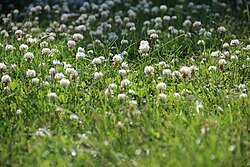Biology:Clover lawn
A clover lawn is composed of clover and can be used as an alternative to grass lawns. It requires less maintenance than a traditional lawn and utilizes less water.[1][2] White clover is the plant most frequently used.[3] Red clover may also be used.[4]
Trend
Clover lawns have grown in popularity, along with other grass alternatives, becoming trends shared across social media platforms like TikTok. As a trend, clover lawns gained widespread attention in 2023, being Google's most searched for home improvement.[5] Historically, particularly in the early 1900s, clover was often intentionally included in turf mixes. After the widespread adoption of herbicides for lawn maintenance, clover eventually became undesirable.[3] Then, clover was typically dealt with as a weed before its newfound resurgence.[6]
Usage and maintenance
White clover, commonly used in clover lawns, attracts pollinators and can have a beneficial effect on local nectar production. It is also a nitrogen fixing plant. White clover is able to withstand damp environments and can be desirable in areas prone to flooding.[1] It also functions as groundcover and can reduce a homeowner's reliance on fertilizer, leading to its desirability among environmentally conscious consumers.[7] To maintain a height of about 3 to 4 inches, it can be mowed every four to six weeks.[8] Other homeowners allow the clover to grow taller and only mow it a few times a year.[4] Clover is also more robust in alkaline soils than grass. A technique, when clover is preferred to grass, is achieved by adding lime to the soil to encourage the clover to dominate the lawn.[9] Research conducted in Iran and former usage shows that either alone or mixed with grass it is more resistant to heat and requires less water to be maintained.[2][10]
Clover lawns are vulnerable to anthracnose and are not desirable in grass used for sports due to the leaves causing more slipping than grass.[10] They are functionally desirable for people engaged in urban chicken keeping as they are useful as green forage for the birds.[11]
See also
- Bouteloua dactyloides
- Companion planting
- Moss lawn
- Pollinator garden
References
- ↑ 1.0 1.1 Hirsh, Ally. "Here's why people are ditching their grass lawns for clover". https://www.nationalgeographic.com/environment/article/grass-lawn-alternatives-clover-moss-sedge-native-plants.
- ↑ 2.0 2.1 سعیدی پویا, الهام; تهرانی فر, علی; گزانچیان, غلامعلی; کاظمی, فاطمه; شور, محمود (April 2021). "ارزیابی چمن های شبدری به عنوان جایگزین چمن های گراسی رایج فضای سبز به منظور کاهش هزینه های سرزنی" (in english, persian). علوم باغبانی 36 (1): 15-16. doi:10.22067/jhs.2021.60852.0. https://archive.org/details/jhs-volume-36-issue-1-pages-15-28. Retrieved 18 December 2023.
- ↑ 3.0 3.1 Koski, Tony. "Clover lawns: Colorado expert shares pros, cons on recent trend". https://gazette.com/life/clover-lawns-colorado-expert-shares-pros-cons-on-recent-trend/article_4ba2e896-e83d-11ed-8e59-af870b318566.html.
- ↑ 4.0 4.1 Wellbank, Lauren; Buiano, Madeline. "Clover Lawns Are the Landscaping Trend That Calls for Just 4 Mowings Per Year". https://www.marthastewart.com/8322420/clover-lawns.
- ↑ Krizia, Ramos. "Clover Lawns are the 2023 Trend That Will Stand the Test of Time". https://www.hgtv.ca/clover-lawns/.
- ↑ Millstein, Hallie. "What Is A Clover Lawn? Here's Everything You Need To Know". https://www.southernliving.com/what-is-a-clover-lawn-6536512.
- ↑ Dixit, Vijay. "Clover lawns rise in Midwest for eco and drought benefits". https://www.eplocalnews.org/2023/10/20/clover-lawns-rise-in-midwest-for-eco-and-drought-benefits/.
- ↑ "How Often Will You Have To Mow A Clover Lawn?". https://www.housedigest.com/1363705/how-often-mow-clover-lawn/.
- ↑ Shewell-Cooper, Wilfred Edward (1976). Mini-work Gardening (1st ed.). London: Adam and Charles Black. pp. 60-61. ISBN 978-0-7136-1623-1. https://archive.org/details/miniworkgardenin0000shew/page/22. Retrieved 18 December 2023.
- ↑ 10.0 10.1 Carleton, R. Milton (1971). Your Lawn: How to Make It and Keep It. New York: Van Nostrand Reinhold Company. pp. 48-49. https://archive.org/details/yourlawnhowtomak0000carl/page/48. Retrieved 18 December 2023.
- ↑ Basley, A. (1922). Western Poultry Book (4th ed.). Los Angeles: Germain Seed and Plant Co.. pp. 23, 108, 110. https://archive.org/details/cu31924003150921/page/n28. Retrieved 19 December 2023.
 |


